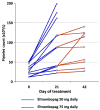Treatment of inherited thrombocytopenias
- PMID: 35642487
- PMCID: PMC9152979
- DOI: 10.3324/haematol.2022.280856
Treatment of inherited thrombocytopenias
Abstract
The new techniques of genetic analysis have made it possible to identify many new forms of inherited thrombocytopenias (IT) and study large series of patients. In recent years, this has changed the view of IT, highlighting the fact that, in contrast to previous belief, most patients have a modest bleeding diathesis. On the other hand, it has become evident that some of the mutations responsible for platelet deficiency predispose the patient to serious, potentially lifethreatening diseases. Today's vision of IT is, therefore, very different from that of the past and the therapeutic approach must take these changes into account while also making use of the new therapies that have become available in the meantime. This review, the first devoted entirely to IT therapy, discusses how to prevent bleeding in those patients who are exposed to this risk, how to treat it if it occurs, and how to manage the serious illnesses to which patients with IT may be predisposed.
Figures






References
-
- Pecci A, Balduini CL. Inherited thrombocytopenias: an updated guide for clinicians. Blood Rev. 2021;48:100784. - PubMed
-
- Bolton-Maggs PH, Chalmers EA, Collins PW, et al. . A review of inherited platelet disorders with guidelines for their management on behalf of the UKHCDO. Br J Haematol. 2006;135(5):603-633. - PubMed
-
- Kumar R, Kahr WH. Congenital thrombocytopenia: clinical manifestations, laboratory abnormalities, and molecular defects of a heterogeneous group of conditions. Hematol Oncol Clin North Am. 2013;27(3):465-494. - PubMed
Publication types
MeSH terms
LinkOut - more resources
Full Text Sources
Medical
Miscellaneous

